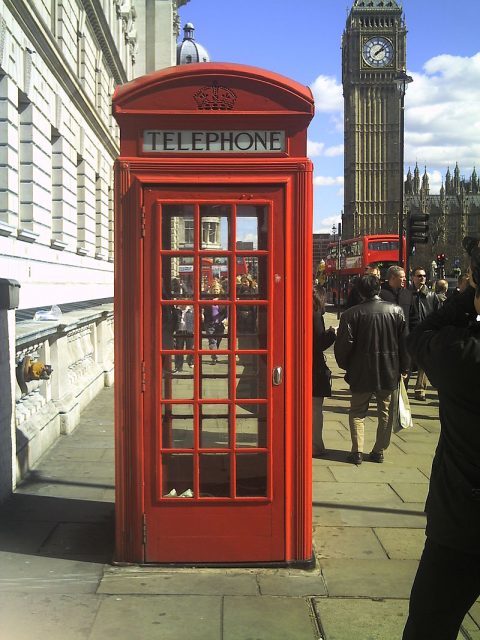Many, many, many years ago, not quite before time began, we had a private telephone line expensively installed in the hallway of our flat.
The party line was cheaper (several residences connected to one line…you’d pick up the receiver and check if others were talking).
Friends & unfortunate acquaintances often did not have a telephone.
If they lived close by, we’d take a chance and knock on their door.
Red telephone boxes, designed by Giles Gilbert Scott, hit the streets in 1926, and were essential for over 50 years for most of the population, who could not afford a telephone line. 60,000 Scott boxes eventually covered the country, with 8,000 still remaining.
To ensure meeting up at a time and place suitable to everyone, we no longer had to send a letter to friends and relations and wait for a reply.
The postman used to deliver our letters three times a day, later, only twice.
The telephone at home, this new device, adopted much earlier by businesses, meant we’d pick up the receiver and dial the number to make contacts with friends, relations or companies.
I still remember ours, GLAdstone 4966, three letters & four numbers.
What a boon. Instant communication.
Wind forward. Email.
Now, at last, instant communication across the world.
Send a message and you would get a reply moments, or occasionally hours afterwards.
Eventually this was too much for each of us as we spent hours every day curating messages, deleting messages and soon deleting the messengers.
This was too much for businesses who then allowed only proprietary messages through their own portals, such as apps.
It made the telephone almost redundant, a place to leave a voice message on an answering machine in an echoing hall inhabited by thousands of other messages.
Then telephones left the hallways and the walls of the nations, and became smartphones, allowing instant contact and allowing everyone, friend or foe, to be in our pockets.
This was somewhat unwise, as every business, every uncle, every family member and even close friends could make contact.
Voices, and unprompted assignations made lots of people nervous.
Aha! Text messages.
Now this fly in the ointment ensured that both telephone and email would make communication even less likely.
After all, perhaps the message did not get through.
Abject apologies. Abject appointments and disappointments.
Never mind. Now we could all have one-way communications with no way of knowing if we were talking to someone or just ourselves.
Did the message get through?
A solution! Facebook, Video messaging. Posting on YouTube.
Now, at last, we could communicate across the world to everyone; brothers and sisters, and my uncle.
And we’d have proof we’d been seen and heard by ticking a box that said like or dislike.
Gosh! A thousand people have seen what I’ve said and done.
Oh no! More ticked the wrong box. A solution was found.
The one’s that dissed you were removed from the score sheet.
Only likes were left on display.
What did they see?
The Twitterati could tell you, but you never knew who they were, or in fact, if they existed or knew anything at all.
Then things became interesting.
Chatbot robots, AI, and their friends, multiplied in our computerised nirvana, billions of pixels inhabiting the airways, rather like microbiota in our bodies, bacteria, archaea, fungi, protists, & viruses.
Nobody now knew if anything they said or did was working or communicated to anyone else or whether we now inhabited a great hall of mirrors. Still, there was one way to be sure.
I left my computer and smartphone at home and walked out into the street. I knocked on the door of a friend, who, much to his astonishment, saw me standing there.
He said, “What a surprise! So lovely to see you. Come in.”
© Christopher 2023 [email protected]
An aside:
Giles Gilbert Scott is claimed to have taken the design of the telephone box from the mausoleum of Eliza Soane, the wife of Sir John Soane.
His son, George Soane, had published articles denigrating the architecture of his father. She died ‘of a broken heart’ just two years later and Sir John never spoke with the son again.
Soane was subsequently buried there.
Thus the red telephone box was born to allow us all commiserations and declarations, without having to do this in person.
Was the red telephone box an opportunity to talk with the spirits or to each other?
And so to the present …and our descent into our halls of reflections.

.


A great reminder and I also remember my number …BoWes Park 1439 if anyone remembers me!
Comment by Caron on 12 August, 2023 at 4:21 pmWhat a delightful and very interesting piece!
With playful humour Chris engages with some very weighty themes; describing so much of what has changed in the world for almost all of us – our dependence on increasingly remote ways of engaging and avoiding one another.
I find in all this – our technically brilliant contagious follies of remote signalling – tragicomic in nature, and increasingly chilling in consequence …
Chris’s portrait makes such sobering material light enough to be entertaining: that’s very worthwhile.
Thanks.
David Zigmond
Comment by David Zigmond on 17 August, 2023 at 9:30 am